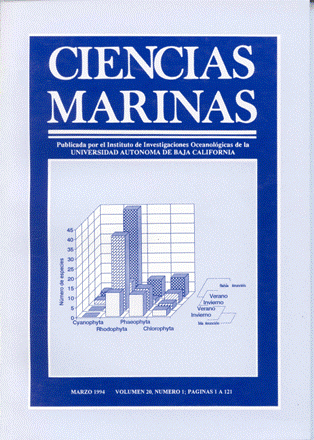Ammonium, nitrite, nitrate and phosphate fluxes across the sediment-water interface in a tropical lagoon
Main Article Content
Abstract
The sediments of Chelem Lagoon, on the coast of the Gulf of Mexico, north of the Yucatán Peninsula, were studied measuring the nutrient concentrations in the interstitial water. The average values were: ammonium 459 ± 281 µM, peaking up to 1,045 µM; nitrite 1.8 ± 1.8 PM, with a maximum of 5.3 µM; nitrate 8.2 ± 10.3 µM, reaching 34.7 µM, phosphate 0.4 ± 0.4 µM, with a maximum of 1.1 µM. Fluxes were estimated with Fick’s first law equation. In al1 cases, the mean flux of the 14 samples from the lagoon were from the sediment to the water column; these values were 182 µmol/m2h for ammonium, 0.5 µmol/m2h for nitrite, 1.9 µmol/m2h for nitrate and 0.03 µmol/m2h for phosphate. In order to determine denitrification rates, incubations of the sediments were carried out under anaerobic conditions with water from the lagoon enriched with nitrate; denitrification was found to be active in five of the 14 samples, with the highest rate in sample No. 8 (16.07 µmol/m2h), which had the greatest content of organic matter (9.2%) and the highest nitrate flux (from the water to the sediment). The calculation of the net flux in the Chelem area showed an important supply from the sediment to the water column of the four nutrients studied, greatest in ammonium.
Downloads
Article Details
This is an open access article distributed under a Creative Commons Attribution 4.0 License, which allows you to share and adapt the work, as long as you give appropriate credit to the original author(s) and the source, provide a link to the Creative Commons license, and indicate if changes were made. Figures, tables and other elements in the article are included in the article’s CC BY 4.0 license, unless otherwise indicated. The journal title is protected by copyrights and not subject to this license. Full license deed can be viewed here.

